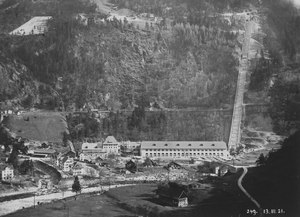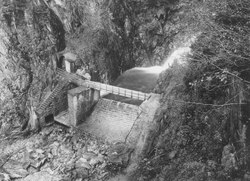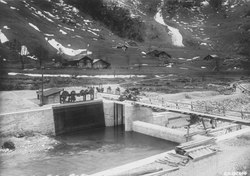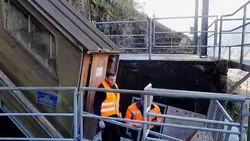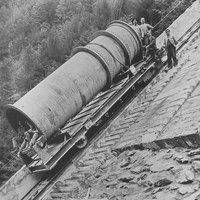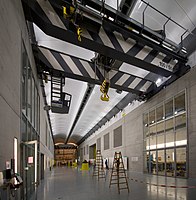Amsteg power plant
| Amsteg power plant | ||
|---|---|---|
| Amsteg I headquarters, now closed, under construction in 1921. On the left the switchgear house, on the right the machine hall and the route of the pressure line . The new Amsteg II headquarters is behind the old one in the interior of the mountain | ||
| location | ||
|
|
||
| Coordinates | 694182 / 180392 | |
| country |
|
|
| place | Silenen UR | |
| Waters | Reuss | |
| Height upstream | 527.5 m above sea level M. | |
| power plant | ||
| owner | Kraftwerk Amsteg AG (KWA), owned by:
|
|
| operator | SBB energy | |
| construction time | 1919–1922 1993–1998 (new headquarters) |
|
| Start of operation | 1923 1998 (new headquarters) |
|
| Shutdown | 1990s (old headquarters) | |
| Listed since | Old headquarters: 1990s | |
| technology | ||
| Bottleneck performance | New headquarters: 120 megawatts | |
| Average height of fall |
289 m | |
| Expansion flow | 50 m³ / s | |
| Standard work capacity | 395 million kWh / year | |
| Turbines | 1923: 6 × horizontal double Pelton turbines 1998: 3 × vertical Pelton turbines |
|
| Generators | 1923: 6 × single-phase generators for traction power supply 1998: 3 × single-phase generators for traction power supply |
|
| Others | ||
| Website | Amsteg hydropower plant | |
| was standing | 2018 | |
The power plant Amsteg the Swiss Federal Railways (SBB) is a high pressure - hydropower plant on the River Reuss in the Canton of Uri . The power plant, together with the plants in Göschenen and Wassen, forms the Reuss cascade, which generates around 40% of the railway power used by SBB. The Amsteg power plant, commissioned in 1923, and the Ritom storage power plant, commissioned in 1920, were the first two power plants to be built to supply the Gotthard Railway with energy .
history
Electrification of the Gotthard Railway
The Gotthard Railway Company (GB) concluded concession agreements in 1907 and 1909 for the use of water in the Reuss Valley and the Leventina . The major problems with coal procurement during the First World War and the higher performance of electric locomotives prompted SBB to push ahead with the rapid electrification of its most important routes. The required single-phase alternating current was to be generated to a large extent by SBB's own power plants.
In 1916 it was stipulated that the hydropower in the two valleys was to be used with five hydropower plants - three on the north side and two on the south side of the Gotthard. Two systems were initially sufficient for the electrical operation of the Gotthard Railway's Erstfeld - Bellinzona line : the Amsteg run-of-river power plant with the small reservoir at Pfaffensprung , which can compensate for the variable water consumption during a day, and the Ritom storage power plant . The Amsteg power plant was able to supply the route with energy on its own for most of the year. Only in the dry winter months had to be supplemented with the Ritomwerk, which had accumulated the water from the snowmelt in the Ritomsee over the summer .
Expansion for Bahn 2000 and Gotthard Base Tunnel
In connection with the Bahn 2000 project and the Gotthard Base Tunnel , the energy demand increased, so that the old headquarters in Amsteg was replaced by a new building in a rock cavern between 1993 and 1998.
For the construction of the new headquarters, a siding was specially built from the Erstfeld train station along the Reuss and today's motorway to Amsteg. The track was later also used to transport the excavated material for the NEAT intermediate attack point at Amsteg of the Gotthard base tunnel .
The water intake at the Pfaffensprung , the water lock , the pressure tunnels and the drainage of the water into the Reuss were also rebuilt. The remaining water is used by the new Pfaffensprung doping center.
The main task of the renewed power plant is to cover the load peaks that occur every hour due to the cycle timetable . When they are processed, large amounts of water are required that cannot be fed directly into the Reuss without the water level rising by up to 70 cm. The water is therefore retained in a cavern and used by the Amsteg regulation plant before it is released into the Reuss.
Commercial operation began on May 1, 1998; the official opening was on September 17, 1998. The plant is operated by Kraftwerk Amsteg AG (KWA), which was founded on June 15, 1992.
technology
Pfaffensprung reservoir
The reservoir in the Reuss valley has a net volume of 190,000 m³. The end is formed by a 32 m high arch dam , which has a crown length of 64.1 m.
Funding center Pfaffensprung (from 1998)
The remaining water from the reservoir into the Reuss is processed by the Pfaffensprung doping center. The installed turbine generates 50 Hz electricity for the national grid and has an output of 720 kW.
Pressure tunnels and water wells
The water for the Amsteg headquarters is taken from the Pfaffensprung reservoir and fed through two 7.5 km long pressure tunnels along the right flank of the valley to the moated castle above Bristen . There are additional water wells on the Fellibach, Chärstelenbach and Etzlibach. The water falls 280 m from the moated castle and drives the Pelton turbines at the headquarters in Amsteg.
Water intake Chärstelenbach
697065 / 180309Water intake Etzlibach
six hundred ninety-six thousand seven hundred / 180173
Headquarters Amsteg I (until 1993)
In the old headquarters were 6 Pelton turbines, the 16 single-phase three 2 / 3 Hz generators drives. It had a peak output of 52 MW. The power plant building directly below the Gotthard line is now largely empty, as the system was replaced by the Amsteg II power plant. The turbine hall, the old pressure line and the funicular are under monument protection. The turbines are still available in the hall, but should be partially removed for an interim use of the building. The SBB plans to use the building for a frequency converter system in the long term .
One of the six disused groups with two Pelton turbines and a single-phase generator
Funicular railway along the old penstock
Headquarters Amsteg II (from 1998)
The new headquarters is designed for an electricity production of 160 megawatts. In the first stage, 120 megawatts will be installed, which will be generated by three single-phase 16.7 Hz generators at 50 MVA. It is located in a 30 m high cavern that is 30 m wide and 90 m long. The turbines are arranged vertically and have three nozzles, above which are the generators. The top floor houses the transformers, which are arranged on the mountain side in relation to the generators.
Regulierzentrale Amsteg (from 1998)
The underwater of Amsteg II is partially held back in order to guarantee an even water level in the Reuss. When the water drains from the underground reservoir in a cavern into the Reuss, the water is processed by the two bulb turbines at the Amsteg control center. The turbines have a combined output of 1739 kW and generate 50 Hz electricity for the national grid.
Overview
| Headquarters | location | Municipal area | Installation | Machine house
[m. ü. M.] |
el. power
in MW |
Type of current | Turbines | Maximum raw head
in m |
Expansion flow in m³ / s | comment |
|---|---|---|---|---|---|---|---|---|---|---|
| Amsteg I | 694182 / 180392 | Silenen UR | 1923 | 528 | 56 | 16 2 / 3 Hz -Bahnstrom | 6 horizontal double Pelton turbines | 289 | 29 | Decommissioned in the 1990s, a listed building |
| Amsteg II | 694278 / 180247 | Silenen UR | 1998 | 528 | 120 | 16 7 Hz railway current | 3 vertical Pelton turbines | 289 | 50 | |
| Amsteg regulatory center | 694010 / 181126 | Silenen UR | 1998 | 510 | 1.73 | 50 Hz - national network | 2 bulb turbines | 46 | regulates the outflow of the underwater from Amsteg II into the Reuss | |
| Pfaffensprung endowment center | 689635 / 174446 | Water | 1998 | 779 | 0.72 | 50 Hz - national network | 1 Francis turbine | 4th | processes the residual water for the Reuss |
Situation map
See also
literature
- Kilian T. Elsasser: Gottardo hiking trail. On foot along the Gotthard Railway. AT-Verlag, Baden 2007, ISBN 978-3-03800-353-3 , pp. 95-96.
-
The Amsteg power station of the Swiss Federal Railways. In: Schweizerische Bauzeitung .
- Hans Studer: I. General and hydraulic engineering part. The water intake. tape 86 , no. 19 , 1925, doi : 10.5169 / seals-40216 .
- Hans Studer: I. General and hydraulic engineering part. The dam. tape 86 , no. 20 , 1925, doi : 10.5169 / seals-40221 .
- Hans Studer: I. General and hydraulic engineering part. The dam ff. Volume 86 , no. 21 , 1925, doi : 10.5169 / seals-40225 .
- Th. Nager: II. Structural part. tape 87 , no. 13 , 1926, doi : 10.5169 / seals-40868 .
- G. Croce: III. Mechanical-electrical part. The turbines. tape 87 , no. 15 , 1926, doi : 10.5169 / seals-40874 .
- G. Croce: III. Mechanical-electrical part. The generators. tape 87 , no. 16 , 1926, doi : 10.5169 / seals-40876 .
Web links
Individual evidence
- ↑ Government council representation in committees. Canton of Uri, June 14, 2016, accessed August 1, 2020 .
- ^ Karl Werlen: Schwall / Sunk: Optimal runoff regime for hydropower plants . In: Water Energy Air 1/2011 . Optimal discharge regime using the example of the Amsteg power plant (KWA), p. 23 ( issuu.com [accessed August 1, 2020]).
- ↑ a b c Federal Office of Energy SFOE (Ed.): Statistics on hydropower plants in Switzerland . January 1, 2018 ( admin.ch - system number 300900). Statistics of the hydropower plants in Switzerland ( Memento of the original from December 9, 2018 in the Internet Archive ) Info: The archive link was inserted automatically and has not yet been checked. Please check the original and archive link according to the instructions and then remove this notice.
- ↑ Remo Infanger: 4 out of 10 trains run on Urner Strom. In: Lucerne newspaper. July 24, 2018 .
- ↑ a b The power plants in Switzerland. Federal railways on the Gotthard . In: Schweizerische Bauzeitung . tape 68 , July 22, 1916, p. 33 , doi : 10.5169 / seals-33038 .
- ↑ a b News in brief . In: Railway amateur . No. 5 , 1996, pp. 270 .
- ↑ Swiss Dam Committee (ed.): Pfaffensprung . ( swissdams.ch [PDF]).
- ↑ Pressure tunnel at the Amsteg power plant. (PDF) Marti Tunnel AG, May 1, 2017 .
- ↑ Federal Office for Water Management (Ed.): Statistics of hydropower plants in Switzerland . 1st January 1973.
- ↑ Marco Molinari, Eduard Müller, Toni Häfliger: The Gotthard Mountain Line as a UNESCO World Heritage Site? Chances and risks of launching a candidacy. December 15, 2006, p. 18 ( raonline.ch [PDF]).
- ↑ Martin Keller: Linth – Limmern cavern center - excavation and security concept . December 13, 2007, p. 22 ( ethz.ch [PDF] presentation).
- ↑ Federal Office for Water Management (Ed.): Statistics of hydropower plants in Switzerland . 1st January 1973.
